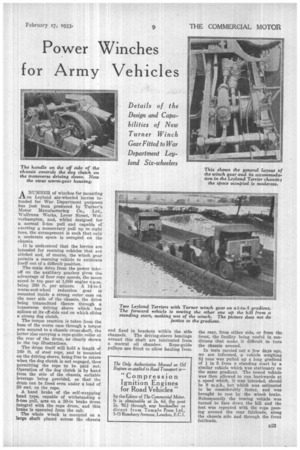Power Winches for Army Vehicles
Page 37

If you've noticed an error in this article please click here to report it so we can fix it.
A NUMBER of winches for mounting
on Leyland six-wheeled lorries intended for War Department purposes has just been produced by Turner's Motor Manufacturing Co., Ltd., Wulfruna Works, Lever Street, Wolverhampton, and, whilst designed for a normal 5-ton pull and capable of exerting a momentary pull up to eight tons, the arrangement is such that only a moderate space is occupied on the ehassis.
It is understood that the lorries are intended for rescuing vehicles that are ditched and, of course, the winch gear permits a rescuing vehicle to extricate itself out of a difficult position.
The main drive from the power takeoff on the auxiliary gearbox gives tho advantage of four rape speeds, the mean speed in top gear at 1,000 engine r.p.m. being 260 ft. per minute. A 14-to-1 worm-and-wheel reduction gear is mounted inside a strong enter case on the near side of the chassis, the drive being transmitted thence through a transverse driving sleeve which has splines at its off-side end on which slides a strong dog clutch.
The torque reaction is taken from the base of the worm case through a torque arm secured to a chassis cross-shaft, the latter also carrying a rope-guide roller at the rear of the drum, as clearly shown in the top illustrations. The drum itself will hold a length Of 160 ft. of steel rope, and is mounted on the driving sleeve, being free to rotate when the dog clutch is not engaged, thus permitting the rope to be paid out. Operation of the dog clutch is by hand from the side of the chassis, suitable leverage being provided, so that the drum can be freed even under a load of 30 cwt. on the rope.
A hand brake of the self-wrapping band type, capable of withstanding a 5-ton pull, acts on a 20-in brake drum Integral with the rope drum, and this brake is operated from the cab.
The whole winch is mounted on a large shaft placed across the chassis
and fixed in brackets within the side channels. The driving-sleeve bearings around this shaft are lubricated front a central oil chamber. Rope-guide pulleys are fitted to allow hauling from the rear, from either side, or from the front, the facility being useful in conditions that make it difficult to turn the chassis around.
In tests carried out a few days ago, we are informed, a vehicle weighing 81 tons was pulled up a long gradient of 1 in 5 from a standing start by a similar vehicle which was stationary on the same gradient. The towed vehicle was then allowed to run backwards at a speed which, it was intended, should be 8 m.p.h., but which was estimated to be considerably faster, and was brought to rest by the winch brake. Subsequently the towing vehicle was turned to face down the hill and the test was repeated with the rope passing around the rear fairleads, along the chassis side and through the front fairleads.




























































































